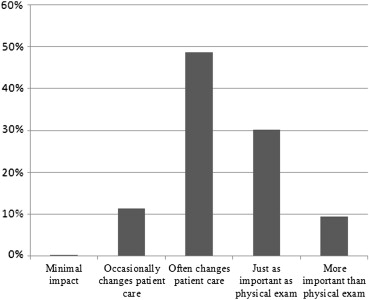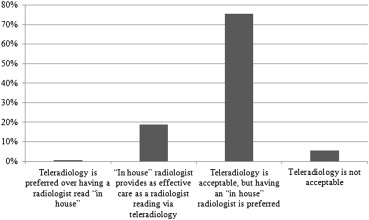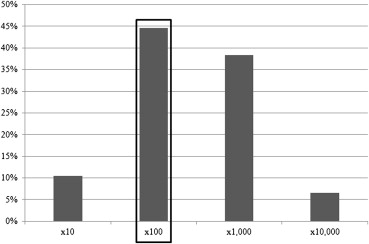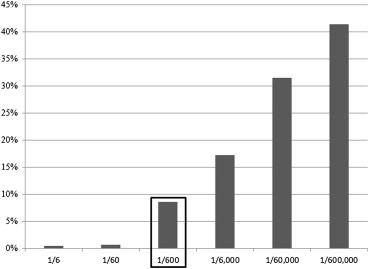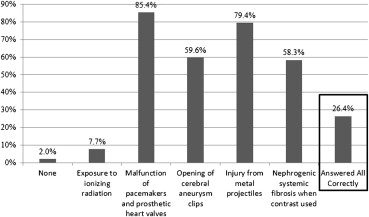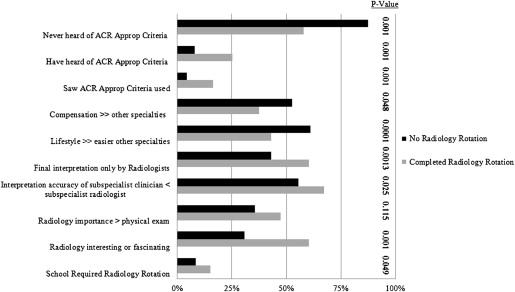Rationale and Objectives
This study evaluates the opinions and knowledge of fourth-year US medical students regarding radiology and analyzes the influence of a required or nonrequired radiology rotation as a reflection of the effectiveness of radiology medical student education.
Methods and Materials
Our institutional review board granted exempt status. An invitation e-mail was sent to 137 US medical schools. Upon receiving approval a second email was sent containing our voluntary anonymous online survey hyperlink to forward to their fourth-year class. Survey topics included demographics, radiology educational experiences, attitudes toward the field, and basic radiology knowledge. Responses were collected between August 4 and September 26, 2011.
Results
A total of 444 fourth-year medical students from 37 medical schools participated: 89% planned to enter a nonradiology specialty, 10.8% were required to take a dedicated radiology rotation, 34.9% completed one, 77% planned to complete one by graduation, 88.4% thought radiology often changes patient care or is at least as important as physical exam, 91.4% underestimated the cancer risk of an abdomen and pelvis computed tomography by at least one order of magnitude, and 72.9% by at least two orders. Seventy-seven percent had never heard of the American College of Radiology (ACR) Appropriateness Criteria. Respondents underestimated the potential risks of magnetic resonance imaging (MRI); with 58.3% aware intravenous gadolinium can cause nephrogenic systemic fibrosis and 79.4% aware of potential injury from metallic projectiles. 40.4% indicated that non-radiologist clinicians in specific medical specialties interpret their respective imaging studies at least as accurately as corresponding subspecialty radiologists. Other results include student opinions regarding teleradiology, radiologist lifestyle, and compensation.
Conclusions
Fourth-year medical students recognize the importance of radiology but are poorly informed regarding radiation safety, MRI safety, and ACR Appropriateness Criteria, despite 34.9% having a dedicated rotation. This highlights the need for adoption of the Alliance of Medical Student Educators in Radiology curriculum.
Medical student radiology education is a vital part of medical training, both to promote the effective and judicious use of radiology resources and to increase awareness of the field. The effectiveness of such training has been evaluated predominantly in single institution studies and not across multiple US centers. The field of radiology and radiology education has changed since many of these studies were published. We sought to determine if medical student opinions and knowledge of radiology and the influence of a dedicated radiology rotation has changed over the past decade across the United States.
Previous studies have suggested that a radiology clerkship improves both medical student opinion of the role of radiology as well as ability to choose an appropriate workup. A 4-week radiology clerkship increased student desire for a radiologist to be involved in patient care and consultation . Students selected more appropriate imaging in survey scenarios, with projected lower costs after a radiology clerkship than before . Students with some preclinical exposure to radiologists were less likely to hold negative stereotypes of radiologists . In the 10 years or more since most of these studies were published, there have been many changes in the field of radiology. There has been a trend toward integrating radiology into the core curriculum by several different strategies. These include adding half-day web-based independent teaching sessions to each of 10 fourth-year clerkships , adding subspecialty faculty lectures during the internal medicine clerkship , and integrating radiology throughout the third year curriculum with readings, shadowing, didactic sessions, radiology rounds, final exam, and case presentations . There has been an increased public awareness of radiology’s role in US population radiation exposure and a dramatic rise in the cost of health care . During this time the American College of Radiology (ACR) Appropriateness Criteria was converted from text-based guidelines to an on-line database . The effectiveness of radiology medical student education since these changes and trends have occurred has not been evaluated across multiple US medical schools.
Get Radiology Tree app to read full this article<
Materials and methods
Subjects
Get Radiology Tree app to read full this article<
Get Radiology Tree app to read full this article<
Survey Instrument
Get Radiology Tree app to read full this article<
Statistical Analysis
Get Radiology Tree app to read full this article<
Institutional Review Board
Get Radiology Tree app to read full this article<
Results
Demographics
Get Radiology Tree app to read full this article<
Table 1
Demographics
Answered All Questions 84.7% All Opinion Questions 89.0% All knowledge questions 88.5% Gender Male 53.2% Female 46.8% School type Allopathic 73.5% Osteopathic 26.5% US region Northeast Midwest South West 19.5% 29.5% 30.6% 20.4% Career plans Radiology Medical Surgical Other/undecided 11.0% 54.6% 21.2% 13.2% Radiology experience Before medical school Preclinical years (lectures) Core clinical rotations (outside of patient care) Dedicated rotation required Completed dedicated rotation Dedicated rotation by graduation 13.0% 71.1% 56.1% 10.8% 34.9% 77%
Get Radiology Tree app to read full this article<
Opinions
Get Radiology Tree app to read full this article<
Table 2
Student Opinions
Question Responses Optimal Time for Radiology Rotation Before Clinical Rotations During Clinical Rotations After Clinical Rotations Unnecessary 21.3% 62.0% 7.6% 9.0% How interesting is radiology? Worthless to me Dull but important Interesting relating to clinical medicine Interesting in its own right Downright fascinating 0.2% 18.1% 34.8% 32.5% 14.4% Impact of radiology Minimal impact Occasionally changes patient care Often changes patient care Just as important as physical exam More important than physical exam 0.2% 11.4% 48.7% 30.2% 9.5% Subspecialty clinician accuracy versus subspecialty radiologist interpretation Much more accurate Slightly more accurate As accurate Slightly less accurate Much less accurate 1.9% 8.7% 29.8% 52.6% 7% Teleradiology versus in-house radiologist Teleradiology preferred Equally effective Teleradiology acceptable, in-house preferred Teleradiology not acceptable 0.5% 18.7% 75.4% 5.4% Why in-house radiologist preferred? Not preferred Review cases in person Discuss best next test Knowledge of radiologist’s reputation, abilities Faster report turnaround 4.3% 89% 70.2% 47.4% 37.2% Why teleradiology preferred? Teleradiology not preferred Less expensive Faster report turnaround 24/7 coverage Rural access to subspecialists 71% 14.6% 6% 25.1% 21.5% Radiologist’s lifestyle Much more difficult than clinician’s Slightly more difficult than clinician’s Same difficulty as clinician’s Slightly easier than clinician’s Much easier than clinician’s 0.2% 0.2% 9.9% 34.9% 54.7% Radiologist’s compensation Much less than clinician’s A little less than clinician’s Same as clinician’s A little more than clinician’s Much more than clinician’s 0.7% 1.2% 9.4% 41.3% 47.3%
None Neurologists Orthopedic Surgeons Emergency physicians General Surgeons Internists Which clinicians should provide final interpretations 49% 42.1% 47% 28.1% 33.5% 22.7%
Get Radiology Tree app to read full this article<
Knowledge
Get Radiology Tree app to read full this article<
Table 3
Student Knowledge
Radiology residency length 2 years 3 years 4 years 5 years 0.5% 11.6% 56.7% 31.2% Chest computed tomography radiation dose = [ ] × chest x-ray 10× 100× 1000× 10,000× 10.5% 44.6% 38.3% 6.6% 30-year-old female lifetime cancer risk of computed tomography abdomen/pelvis 1/6 1/60 1/600 1/6000 1/60,000 1/600,000 0.5% 0.7% 8.6% 17.2% 31.5% 41.4% Risks of magnetic resonance imaging None Ionizing radiation Pacemaker, prosthetic valve malfunction Open cerebral aneurysm clips Metal projectile injury Nephrogenic systemic fibrosis with contrast 2% 7.7% 85.4% 59.6% 79.4% 58.3% American College of Radiology appropriateness criteria Seen it used Heard of it, never seen used Never heard of it 8.8% 14.3% 77% Chest x-ray cost $75 $300 $2000 $5000 49.8% 49.8% 0.5% 0% Abdominal computed tomography cost $75 $300 $2000 $5000 0% 28.2% 67.8% 4% Abdominal ultrasound cost $75 $300 $2000 $5000 51.6% 44.3% 4% 0%
Get Radiology Tree app to read full this article<
Influence of a Radiology Rotation
Get Radiology Tree app to read full this article<
Get Radiology Tree app to read full this article<
Influence of a Radiology Requirement
Get Radiology Tree app to read full this article<
Influence Type of Medical School
Get Radiology Tree app to read full this article<
Table 4
Allopathic versus Osteopathic Student Responses
Allopathic Osteopathic_P_ Value Should clinicians provide final interpretations of imaging studies they order? (Check all that apply.) None 50.5% 44.7% Neurologists 39.8% 48.5% Orthopedic surgeons 45.3% 51.5% Emergency room physicians 27.0% 30.1% General surgeons 31.8% 37.9% Internists 22.5% 22.3% <.001 What is the lifetime cancer risk of a single phase abdomen and pelvis computed tomography in a 30-year-old woman? 1/6 0.7% 0.0% 1/60 0.7% 0.0% 1/600 8.3% 9.6% 1/6,000 15.9% 18.3% 1/60,000 33.6% 27.9% 1/600,000 40.8% 44.2% <.001
Get Radiology Tree app to read full this article<
Influence of Career Plans
Get Radiology Tree app to read full this article<
Table 5
Influence of Career Plans on Opinions
Career Plans Radiology Medical Surgical Other/Undecided Non-Radiology_P_ Value How interesting is the subject matter of radiology? <.001 Worthless 0.0% 0.5% 0.0% 0.0% 0.3% Dull, but important 2.4% 20.9% 16.7% 25.5% 20.6% Interesting clinically 2.4% 42.7% 33.3% 33.3% 39.3% Interesting in own right 14.6% 30.9% 46.2% 29.4% 34.1% Downright fascinating 80.5% 5.0% 3.8% 11.8% 5.7% Impact of radiology on patient care .012 Minimal 0.0% 0.5% 0.0% 0.0% 0.3% Occasional 2.4% 13.2% 14.1% 11.8% 13.2% Often 34.1% 50.2% 42.3% 52.9% 48.9% Importance = physical exam 36.6% 28.3% 34.6% 33.3% 30.5% Importance > physical exam 26.8% 7.8% 9.0% 2.0% 7.2% Subspecialty clinician interpretation accuracy compared to subspecialty radiologists <.001 Much higher 0.0% 2.3% 3.8% 0.0% 2.3% Little higher 0.0% 9.3% 11.5% 9.8% 9.9% Equal 17.1% 29.8% 35.9% 35.3% 32.0% Little lower 56.1% 54.9% 47.4% 49.0% 52.3% Much lower 26.8% 3.7% 1.3% 5.9% 3.5% Radiologist’s professional lifestyle compared to medical and surgical clinicians <.001 Much harder 0.0% 0.0% 0.0% 2.1% 0.3% Little harder 2.4% 0.0% 0.0% 0.0% 0.0% Similar 26.8% 6.2% 6.7% 10.6% 6.9% Little easier 51.2% 35.9% 22.7% 34.0% 32.6% Much easier 19.5% 57.9% 70.7% 53.2% 60.1% Radiologist’s compensation compared to medical and surgical clinicians <.001 Much less 2.4% 0.5% 0.0% 0.0% 0.3% Little less 2.4% 1.0% 2.7% 0.0% 1.2% Similar 17.1% 8.6% 13.3% 0.0% 8.4% Little more 68.3% 35.7% 44.0% 38.3% 38.0% Much more 9.8% 54.3% 40.0% 61.7% 52.1% Should subspecialty clinicians provide final interpretations on studies? (Check all that apply.) <.001 None 85.4% 42.4% 45.2% 51.1% 44.3% Neurologists 12.2% 50.7% 39.7% 36.2% 46.2% Orthopedic surgeons 14.6% 52.2% 52.1% 44.7% 51.1% Emergency room physicians 7.3% 34.1% 23.3% 34.0% 31.7% General surgeons 7.3% 37.1% 38.4% 34.0% 36.9% Internists 7.3% 30.2% 16.4% 17.0% 25.5%
Table 6
Influence of Career Plans on Knowledge
Career Plans Radiology Non-Radiology_P_ Value Nephrogenic systemic fibrosis risk of magnetic resonance imaging contrast .003 Aware of risk 80.5% 56.4% Unaware 19.5% 43.6% American College of Radiology Appropriateness Criteria <.001 Heard of it; seen it used 22.5% 6.6% Heard of it; not seen it used 22.5% 12.9% Never heard of it 55.0% 80.6%
Get Radiology Tree app to read full this article<
Discussion
Get Radiology Tree app to read full this article<
Get Radiology Tree app to read full this article<
Get Radiology Tree app to read full this article<
Get Radiology Tree app to read full this article<
Get Radiology Tree app to read full this article<
Get Radiology Tree app to read full this article<
Get Radiology Tree app to read full this article<
Get Radiology Tree app to read full this article<
Get Radiology Tree app to read full this article<
Get Radiology Tree app to read full this article<
Get Radiology Tree app to read full this article<
Get Radiology Tree app to read full this article<
Appendix 1
Survey instrument
Get Radiology Tree app to read full this article<
Get Radiology Tree app to read full this article<
Get Radiology Tree app to read full this article<
Get Radiology Tree app to read full this article<
Get Radiology Tree app to read full this article<
Get Radiology Tree app to read full this article<
Get Radiology Tree app to read full this article<
Get Radiology Tree app to read full this article<
Get Radiology Tree app to read full this article<
Get Radiology Tree app to read full this article<
Get Radiology Tree app to read full this article<
Get Radiology Tree app to read full this article<
Get Radiology Tree app to read full this article<
Get Radiology Tree app to read full this article<
Get Radiology Tree app to read full this article<
Get Radiology Tree app to read full this article<
Get Radiology Tree app to read full this article<
Get Radiology Tree app to read full this article<
Get Radiology Tree app to read full this article<
Get Radiology Tree app to read full this article<
Get Radiology Tree app to read full this article<
Get Radiology Tree app to read full this article<
Get Radiology Tree app to read full this article<
Get Radiology Tree app to read full this article<
Get Radiology Tree app to read full this article<
Get Radiology Tree app to read full this article<
Get Radiology Tree app to read full this article<
Get Radiology Tree app to read full this article<
Get Radiology Tree app to read full this article<
Get Radiology Tree app to read full this article<
Get Radiology Tree app to read full this article<
Get Radiology Tree app to read full this article<
Get Radiology Tree app to read full this article<
Get Radiology Tree app to read full this article<
References
1. Blane C.E., Ten Haken J.D., Vydareny K.H., et. al.: Medical student attitudes toward radiology: a multi-institutional survey. Invest Radiol 1989; 24: pp. 77-80.
2. Scheiner J.D., Novelline R.A.: Radiology clerkships are necessary for teaching medical students appropriate imaging work-ups. Acad Radiol 2000; 7: pp. 40-45.
3. Branstetter B.F., Humphrey A.L., Schumann J.B.: The long-term impact of preclinical education on medical students’ opinions about radiology. Acad Radiol 2008; 15: pp. 1331-1339.
4. Chew F.S., Relyea-Chew A.: Distributed web-supported radiology clerkship for the required clinical clerkship year of medical school: development, implementation, and evaluation. Acad Radiol 2002; 9: pp. 713-720.
5. Relyea-Chew A., Chew F.S.: Dedicated core clerkship in radiology for medical students: development, implementation, evaluation and comparison with distributed clerkship. Acad Radiol 2007; 14: pp. 1127-1136.
6. Collins J., Dotti S.L., Albanese M.A.: Teaching radiology to medical students: an integrated approach. Acad Radiol 2002; 9: pp. 1046-1053.
7. Shaffer K., Ng J.M., Hirsh D.A.: An integrated model for radiology education: development of a year-long curriculum in imaging with focus on ambulatory and multidisciplinary medicine. Acad Radiol 2009; 16: pp. 1292-1301.
8. Image Gently Campaign. Available at: http://www.pedrad.org/associations/5364/ig/ . Accessed April 26, 2012.
9. National Coalition on Health Care Website. Health insurance costs: facts on the cost of health insurance and health care. Available at: www.nchc.org/facts/cost.shtml . Accessed July 13, 2008.
10. Sistrom C.L.: The ACR appropriateness criteria: translation to practice and research. J Am Coll Radiol 2005; 1: pp. 61-67.
11. ERAS Medical School Directory. Available at: https://www.aamc.org/services/eras/directory . Accessed May 13, 2012.
12. Huda W.: Review of Radiologic Physics.3rd edition2009.Lippincott Williams & WilkinsPhiladelphia, Pa p. 109
13. New Choice Health medical cost comparison. Available at: http://www.newchoicehealth.com . Accessed July 13, 2011.
14. Poot J.D., Hartman M.S., Daffner R.H.: Understanding the US medical school requirements and medical students’ attitudes about radiology rotations. Acad Radiol 2012; 19: pp. 369-373.
15. Landro L. Radiation risks prompt push to curb CT scans. Wall Street Journal . http://online.wsj.com/article/SB10001424052748704299804575095502744095926.html . Accessed May 7, 2012.
16. Logie C.I., Smith S.E., Nagy P.: Evaluation of resident familiarity and utilization of the ACR musculoskeletal study appropriateness criteria in the context of medical decision support. Acad Radiol 2010; 17: pp. 251-254.
17. Bautista A.B., Burgos A., Nickel B.J., et. al.: Do clinicians use the American College of Radiology Appropriateness criteria in the management of their patients?. AJR Am J Roentgenol 2009; 192: pp. 1581-1585.
18. Koontz N.A., Gunderman R.B.: Radiation safety and medical education: development and integration of a dedicated educational module into a radiology clerkship, outcomes assessment, and survey of medical students’ perceptions. Acad Radiol 2012; 19: pp. 491-497.
19. NCRP Report No. 160: Ionizing Radiation Exposure of the Population of the United States. Available at: http://www.ncrponline.org/Publications/Press_Releases/160press.html . Accessed May 7, 2012.
20. Rice H.E., Frush D.P., Harker M.J., et. al.: Peer assessment of pediatric surgeons for potential risks of radiation exposure from computed tomography scans. J Pediatr Surg 2007; 42: pp. 1157-1164.
21. Horowitz J.M., Yaghmai V., Miller F.H., et. al.: Will CT ordering practices change if we educate residents about the potential effects of radiation exposure? Experience at a large academic medical center. Acad Radiol 2011; 18: pp. 1447-1452.
22. Sistrom C.L., Dang P.A., Weilburg J.B., et. al.: Effect of computerized order entry with integrated decision support on the growth of outpatient procedure volumes: seven-year time series analysis. Radiology 2009; 251: pp. 147-155.
23. Dillon J.E., Slanetz P.J.: Teaching evidence-based imaging in the radiology clerkship using the ACR appropriateness criteria. Acad Radiol 2010; 17: pp. 912-916.
24. National Resident Matching Program : Results and data: 2011 main residency match.April 2011.National Resident Matching ProgramWashington, DC Available at: http://www.nrmp.org/data/resultsanddata2011.pdf Accessed January 9, 2012
25. AMSER National Medical Student Curriculum in Radiology. Available at: http://www.aur.org/Affiliated_Societies/AMSER/amser_curriculum.cfm . Accessed May 13, 2012.
26. Gunderman R.B., Hill D.V.: Student concerns and misconceptions about a career in radiology. Acad Radiol 2012; 19: pp. 366-368.
